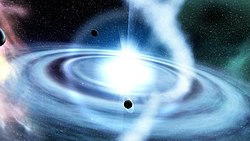| Demoscene |
|---|
 |
| Concepts |
| Alternative demo platforms |
| Current parties |
| Websites |
| Magazines |
| Software |
This article needs additional citations for verification. (April 2010) |
The plasma effect is a computer-based visual effect animated in real-time. It uses cycles of changing colours warped in various ways to give an illusion of liquid, organic movement.
the plasma effect involves manipulating color values over time and space, often using a gradient color palette that shifts to produce a dynamic, animated visual. By combining several sine waves across the x and y axes, the effect achieves a smooth and continuous look. In some implementations, color palettes are used to shift the hue of the entire effect, creating a flowing and vibrant motion.
This effect can be achieved programmatically by generating pixel values based on mathematical formulas. It is a popular technique in shaders and graphical effects to create visually appealing animations.[1]


Plasma is the name of a VGA graphics demo created by Bret Mulvey in 1988 and released on CompuServe. It uses a diamond-square algorithm to generate a 2D pattern, and then cycles the colors using hardware palette in its 256-color mode.
Plasma was picked up by demo coders for their demos where the effect was heavily used, especially in the early 1990s. The effect was particularly common on the Amiga where it could be implemented very efficiently with its display hardware features. Plasma can also be implemented easily in software rendering by using sinus tables and pseudocolor palettes, and it has also been the first true demo effect for many beginning PC democoders.
The fractal software Fractint also incorporates an algorithm known as "plasma", which, when combined with the color cycling feature of the software, can provide a result which resembles a typical plasma effect used in demos. The technical basis, however, is completely different, and a color cycling plasma is somewhat less dynamic than a demo plasma.
Similar effects can be implemented on modern GPUs using pixel shaders.
- ^ "What are the main concepts behind building the plasma effect with GSLS?". Computer Graphics Stack Exchange. Retrieved 2024-09-09.